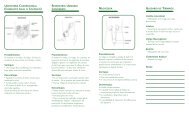Continent Diversion - United Ostomy Associations of America
Continent Diversion - United Ostomy Associations of America
Continent Diversion - United Ostomy Associations of America
Create successful ePaper yourself
Turn your PDF publications into a flip-book with our unique Google optimized e-Paper software.
<strong>Continent</strong> Urinary <strong>Diversion</strong>s<br />
Understanding and Managing<br />
an Internal Pouch<br />
By Roni Olsen, Metro Denver UOAA<br />
During the second revision <strong>of</strong> my husband Ben’s ileal<br />
conduit, it was removed and replaced with an internal<br />
continent Kock pouch with an abdominal stoma. With<br />
gritty determination, he fought his way back to health.<br />
Now 74, he continues to enjoy a busy and physically<br />
active lifestyle.<br />
As a result, we learned a great deal about urostomies<br />
in general and the pros and cons <strong>of</strong> the three different<br />
types <strong>of</strong> urinary diversions: an ileal conduit that requires<br />
an external appliance, an internal continent Kock<br />
pouch that requires convenient catheterization through<br />
an abdominal stoma, and the internal continent pouch/<br />
neobladder that is reconnected to the urethra to provide<br />
near-normal urination.<br />
We also learned a urinary diversion provides a<br />
second chance at life for those whose urinary bladders<br />
must be removed. Understanding the critical role <strong>of</strong><br />
ostomy surgery is essential to both the physical and<br />
psychological adjustment to the altered body function<br />
and diminished self-esteem that routinely accompany<br />
most ostomy surgeries.<br />
As body strength is regained, dealing with an ostomy<br />
actually becomes routine, but the psychological<br />
adjustment <strong>of</strong>ten takes a much longer period. Some<br />
people will have the support <strong>of</strong> a caring family and/or<br />
friends to help them through the process, while others<br />
less fortunate may have to fi ght the uphill battle alone.<br />
Whatever the circumstance, each urostomate’s attitude<br />
is ultimately the key to life with a urinary diversion. An<br />
ostomy need not permanently limit a person’s activities,<br />
abilities, interests or horizons. The urostomate in tune<br />
with life will understand that each day is to be treasured<br />
and not wasted.<br />
Internal <strong>Continent</strong> Pouches<br />
There are two types <strong>of</strong> internal continent urinary<br />
pouches (also called reservoirs): the internal pouch<br />
with an abdominal stoma and the internal pouch that is<br />
reconnected to the urethra (neobladder). These internal<br />
continent urinary pouches with abdominal stomas are<br />
similar to a normal urinary bladder, except they are not<br />
connected to the urethra. Instead, they are connected<br />
to an abdominal stoma located on the abdomen. These<br />
pouches are emptied by patient self-catheterization<br />
through the stoma. The most common internal<br />
continent urinary pouches include the Kock pouch and<br />
the Indiana pouch and several variations, including the<br />
Mainz, Miami, Florida, Studer and Mitr<strong>of</strong>an<strong>of</strong>f pouches.<br />
Kock Pouches<br />
The Kock continent urinary pouch (pronounced<br />
“coke”) is made from approximately two feet <strong>of</strong> ileum.<br />
A valve is created at each end <strong>of</strong> the pouch. The ureters<br />
are connected to the internal valve which prevents refl ux<br />
to the kidneys and the end <strong>of</strong> the other valve is brought<br />
to the abdominal surface to form a small continent<br />
stoma. The Kock pouch is emptied by inserting a fl exible<br />
silicone catheter with a coude’ tip (‘elbow’ or angled<br />
tip) into the stoma four to eight times a day.<br />
Indiana Pouch<br />
The Indiana-type pouches are easier to construct<br />
than the Kock pouch, but they hold a smaller volume<br />
<strong>of</strong> urine. Typically, segments <strong>of</strong> both small and large<br />
intestine are used to form these pouches and usually the<br />
ileo-cecal valve (the valve between the large and small<br />
intestine) becomes the continence valve. Stomas for<br />
these pouches are frequently placed in the bellybutton,<br />
and catheterizing is usually required every four to six<br />
hours. In some cases, patients are also instructed to<br />
irrigate their pouches to help remove mucus, generally<br />
a few times a week.<br />
Any feeling <strong>of</strong> fullness or discomfort in any <strong>of</strong> these<br />
pouches, or feeling <strong>of</strong> cramping or nausea, usually<br />
means the pouch needs to be emptied. Excessive<br />
fl uid intake at any time may result in the need for<br />
more frequent catheterization. Regardless <strong>of</strong> the time<br />
between catheterizations, these feelings should never<br />
be ignored. Catheterization <strong>of</strong> the stoma is convenient,<br />
easy, painless and maintenance is minimal. Since they<br />
don’t leak, they don’t require an external appliance and<br />
their stomas can be made almost fl ush with the skin.<br />
Catheterization <strong>of</strong> the<br />
Internal <strong>Continent</strong> Pouch<br />
Techniques for catheterization will vary slightly<br />
16 The Phoenix <strong>Continent</strong> <strong>Diversion</strong> New Patient Guide








